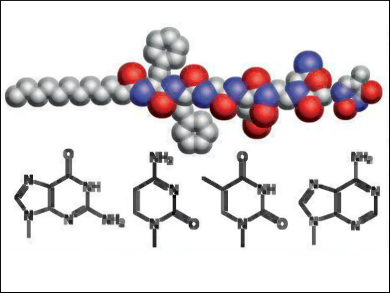Chirality is an essential property in biological systems. Mimicking the natural process of creating chiral structures has inspired chemists to synthesize artificial helical assemblies.
Molly Stevens, Imperial College London, UK, and colleagues have synthesized supramolecular DNA-mimicking fibrils. The team used biologically inspired nucleobase-peptide conjugates (NPCs, conjugate structure and nucleobases pictured above). These conjugates self-assemble to form helical fibrils, where the nucleobases are displayed on the fibril surface. The chirality of the helix can be switched by changing the stereochemistry of the amino acids in the NPCs. Recognition between nucleic acids and the NPC fibrils through cytosine–guanine base pairing was also demonstrated. This process mimics DNA hybridization.
By taking advantage of metal–nucleobase affinity, the nanohelices can be used to bind silver, gold, and palladium nanoparticles. In particular, Ag nanoparticles on thymine-containing nanohelices were so well organized that the resulting plasmonic chirality of silver could be observed spectroscopically. According to the researchers, these structures could be further developed to control the nucleation and growth of inorganic nanocrystals, as well as DNA/RNA-templated self-assembly.
- Plasmonic Chirality Imprinting on Nucleobase-Displaying Supramolecular Nanohelices by Metal-Nucleobase Recognition,
Yiyang Lin, E. Thomas Pashuck, Michael R. Thomas, Nadav Amdursky, Shih-Ting Wang, Lesley W. Chow, Molly M. Stevens,
Angew. Chem. Int. Ed. 2017.
DOI: 10.1002/anie.201610976



